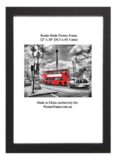No, but we can at least refer to oldest, known, surviving picture frame now at the British Museum in London. It  is a Roman-era, wood-framed, mixed tempera portrait of a woman, with extant, hanging cord of palm fibre, made in Egypt at about AD 50-70. It would seem that as soon on as man (or a woman) learned to draw picture of his loved ones on some portable media, such as wood .. .panel, he would also have wanted it to put a frame around it and hang it. And while the British Museum picture frame is over two ... millennia old, picture frames may even have been invented earlier.
is a Roman-era, wood-framed, mixed tempera portrait of a woman, with extant, hanging cord of palm fibre, made in Egypt at about AD 50-70. It would seem that as soon on as man (or a woman) learned to draw picture of his loved ones on some portable media, such as wood .. .panel, he would also have wanted it to put a frame around it and hang it. And while the British Museum picture frame is over two ... millennia old, picture frames may even have been invented earlier.
Paintings seem to predate picture frames with frescoes (paintings on walls) found with border decorations ( stylised frames ) as far back as 2,500 years ago in Egyptian tombs. Later Greek and Roman public and private edifices have been discovered with frescoes, murals and mosaics. These were adorned with borders or perimeter designs thus framing the artwork in the beholders' eyes, or a precursor to a picture frame.
Picture frames became to more widely used and known in the 12th and 13th centuries. These were carved from one piece or wood, rather being made up of 4 joined sections as is the case now. The top and sides of the frame to be painted were plastered with gesso and gilded. Apparently sometimes later, artists began painting directly on portable, wooden panels with gilded , embellished edges which gradually developed into distinct, separate, moveable picture frames.
However making frames by this method was not only time-consuming but expensive. Someone, perhaps a carpenter, artisan or woodworker thought of making moulded lengths. Such frames would later be cut and joined to make a single frame later attached to a panel where the artwork would be painted upon. This was the forerunner of the modern technique of making frames by the so-called 'engaged' method.
This method yielded fabricated picture frames similar to the single-piece carved frame at a cheaper price and faster completion. While the cost of picture frames was lower, it was still prohibitively expensive for most of the populace. In antiquity and during the middle ages only the royalty, the nobility and the ecclesiastical class could afford to commission work of arts such portraits and their concomitantly expensive, gilded picture frames.
Sculptures and oil paintings were most often commissioned to affirm and encourage religious worship. The gilt, gold and precious stones set in early medieval altar frames sought to portray the splendour of heaven and God's domain. The later, Southern European elaborate altarpieces developed in middle and late medieval centuries suggested instead holy but earthy edifices. These were constructed with the nave, aisles, altar and crypt section in mind, each being a figurative representation of a church or cathedral.
All European nations, kingdoms and city-states produced their own native, holy picture framing styles. As Europe developed politically, the power and might of the church lessened. Divine gave way to secular, artists began to paint less and less for cardinals or bishops and more and more for rich princes and merchants. Thus the art of frame-making also began to change. Painters became less enslaved to ecclesiastical commissions and found new artistic freedom.
The cities and provinces of Italy were most fertile, with Florence, Rome and Venice being particularly creative and ingenious with the renown Renaissance cassetta frame being but one example. France later gave the the French Rococo frame. Later centuries, witnessed painters who worked for rich or well-to-do patrons who commissioned not only art but also highly customised picture frames to highlight their status, importance, or wealth to visitors.
Frequently, in the 1600's picture frames were made out of oak. Later in the 1700's, pine started to became more used and popular, largely because of its lighter and softer composition which made it easier to manufacture with. And because artists recognized that a picture frame is an extension of the image it houses, painters began more and more to create their own unique, elaborate, gilded or painted frames. The age of enlightenment also encompassed a blossoming of picture framing, picture frames and picture framers.
The Renaissance saw more exotic picture framing wood selections such as walnut, linden chestnut or elm, These were chosen for their structural and decorative ease of manufacture. The epicentre of the arts shifted from the once-powerful Italian cities to where money and power now shifted, to the great trading and seafaring nations of The Netherlands, Great Britain and France. The riches of Indonesia, India and New France fed the extravagance and opulence of European merchant princes and royal houses with their commissioning of the personal and familial portraits.
These became almost, de-riguer, wealth and power accoutrements which helped the resurgence of splendidly rich gold-leaf frames. Portraits and commissions from monarchs and other nobles saw the use of frames and other decorative materials which related to their riches and power. The richer and more noble or powerful a person was, the higher the workmanship, decorations and quality a picture frame tended to be. Walnut and ebony frames, inlaid with mother-of-pearl, tortoiseshell and ivory were not infrequently commissioned.
Even as late as the 19th century most picture framers catered only for the well-to-do because picture frames were still a relative luxury, out of reach of most workers, servants, peasants and framers. The industrial revolution also revolutionized picture framing. Gradually, these mass-produced picture frames, became popular because of their increased affordability. In England, the 18th century of Georgian and Regency styles saw the use and purchase of pictures spreading down as domestic fittings and available to middle and even, lower classes.
This was also the era of mechanization, the steam engine and the discovery and adoption of cellulose to make cheap newsprint and paper-making. Pamphlets, newssheets and prints, either as popular art or mordant political debate and satire became more widespread. These new media became picture framed more and more frequently. Picture frame factories grew and expanded to meet the new demand for affordable wooden mouldings with which make inexpensive picture frames.
This enhanced affordability was because these new picture frames were now designed and mass-produced by industrial furniture builders instead of exclusive, renown artists and expensive architects. The 19th century witnessed the continued progress and growth of printed art, largely for the lower classes. Of course the nobility, landed gentry and better-to-do still commissioned portraits, to underline their greater wealth, better parentage and higher social status.
They kept on requiring expensive, gilded frames, but their importance and market share of the greater picture framing market declined. The mid 19th century also saw the invention of colour printing machine which brought down the price of colour papermaking and print making. Magazines and periodicals such as The Illustrated London News began to be printed with coloured prints inside which buyers could remove and put into picture frames. With the advent of modern times, technology devised even cheaper picture framing materials.
PVC and plastic. These new machines and production methods now allow for picture frames to be produced cheaper yet, as low as a few cents per frame, in some cases. For those who are interested in the taxonomy and nomenclature used in the fine arts and picture framing industry, more information is available at our Fine Arts and Picture Framing Alphabetical Glossary. Thank you for reading this post "Does anyone know when was the first picture frame made?".









Goodness, what an interesting read! I didn’t know picture frames had been around for that long nor that the Romans invented them. My daughter and I are are both studying arts and we were googling materials for an assignment when we found this blog. We’re particularly interested in the history of the development of European picture framing and might use some of the things here for our essay. Hope you don’t mind.
Well then, would anyone care to guess when the last picture frame will be made? So Ok we know that digital picture frames didn’t take off, some years back, but that was because of high prices and messy technology. But what with all new technologies, better imagery and economies of scale in pricing, I think that digital picture frames, or some sort of personal, portable, electronic display medium or device will eventually kill off all picture frames and picture framers, so goodbye picture framing industry..
[…] what have you are all designed to accomplish one task, to be shown and to be displayed. And for around 2,000 years or so this has been the practice. Who are we to advise to the […]